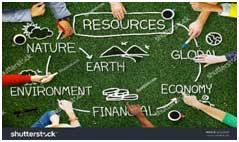Date. 3rd October 2023
Natural Resource Management is an approach in which societies manage the supply of natural resources upon which they rely for their survival and development. As humans are fundamentally dependent on natural resources, ensuring the ongoing access to steady provision of natural resources has always been central to the organization of civilizations and, historically, has been organized through a range of schemes varying in degrees of formality and involvement from the central authorities.
A natural resource is one that is afforded by nature without human intervention, hence, the fertile lands or the minerals within them, rather than the crop that grows on them, are examples of a country’s natural resources. Although what is considered a resource or, for that matter, naturalhas varied over time and from one society to another.Resources are ultimately, riches provided by nature from which can be derived some form of benefit, whether material or immaterial. Under some definitions, only those natural resources that can renew themselves and whose exploitation relies on their regenerative capacities properly necessitate management. For example, oil is not usually considered a subject of natural resource management, whereas forests are. The use of nonrenewable resources is subject to regulation rather than management. The management of renewable natural resources seeks to balance the demands of exploitation with a respect for regenerative capacities.
The emergence of a rational systematic management of natural resources can be traced back to the phase of accelerated industrialization of the late 19th century. In a period of unprecedented industrial growth, the pressures brought to bear on the supply of raw materials and natural resources by an unrelenting demand intensified the need to rationalize their utilization, so as to eliminate increasingly costly waste and to allocate them more efficiently. That coincided with a broader tendency toward rationalization, a general social pattern identified by the sociologist Max Weber that emerged in modern industrial societies in response to the large-scale reorganization of production and whereby goal-oriented rationality was increasingly infused into the organization of social activities. Natural resource management was born at the conjunction of rationalization and its twin process, bureaucratization, which yielded the first bureaucracies to manage nature.
There were huge variations in both the rates and degrees to which the different states became involved with questions of natural resource management. The French state, for example, took a heavy hand in forestry management as early in the 17th century, when wood became a strategic resource at a time of accelerated mercantilist, export-oriented growth that relied primarily on maritime transportationnamely, wooden ships. Such local variations aside, overall, it took a certain kind of state, the modern bureaucratic state, to steer the exploitation of natural resources toward principles of scientific management. In the United States, natural resource management was made a federal matter for the first time under the presidency of Theodore Roosevelt. At that time, principles of scientific management, which combined notions of rational management with in-depth scientific knowledge of the resource itself, were promoted by key figures such as Gifford Pinchot, who took a leading role in the U.S. government’s management of forests in the 1890s and served as head of the Forest Service from its creation, in 1905, to 1910. In Europe a similar concern with rational resource exploitation transpired at about the same time. The International Council for the Exploration of the Sea established 1902, for example, provided a forum in which northern European countries could share concerns about maritime research and resources. It was effectively one of the first international conferences on a natural resource management question, and there too science was entrenched as a basis for exploitation of the seas, laying the grounds for future arrangement for the management of collective resources.
Resource refers to all the materials available in our environment which are technologically accessible, economically feasible and culturally sustainable and help us to satisfy our needs and wants. Resources can broadly be classified upon their availability they are classified into renewable and non-renewable resources. They can also be classified as actual and potential on the basis of the level of development and use, on the basis of origin they can be classified as biotic and abiotic, and on the basis of their distribution, as ubiquitous and localised private, community-owned, national and international resources. An item becomes a resource with time and developing technology.
The benefits of resource utilizationinclude increased wealth, proper functioning of a system, or enhanced well-being. From a human perspective, a natural resource is anything obtained from the environment to satisfy human needs and wants.[1] From a broader biological or ecological perspective, a resource satisfies the needs of a living organism.
The concept of resources has been developed across many established areas of work in economics, biology and ecology, computer science, management, and human resources for example linked to the concepts of competition, sustainability, conservation, and stewardship. In application within human society, commercial or non-commercial factors require resource allocation through resource management.
The concept of a resource can also be tied to the direction of leadership over resources, this can include the things leaders have responsibility for over the human resources, with management, help, support or direction such as in charge of a professional group, technical experts, innovative leaders, archiving expertise, academic management, association management, business management, healthcare management, military management, public administration, spiritual leadership and social networking administrator.
Individuals exploit the same amount of resource per unit biomass to absolutely size-asymmetric the largest individuals exploit all the available resource. The degree of size asymmetry has major effects on the structure and diversity of ecological communities, example in plant communities size-asymmetric competition for light has stronger effects on diversity compared with competition for soil resources. The degree of size asymmetry has major effects on the structure and diversity of ecological communities.


PGDCM PGDSM PGCPM MQSI SACD
Construction- Quantity Surveyor- Valuer/ Appraiser. Project Management
37 PattensenTurkeyen, Dennis Street, Georgetown, Guyana
Email. Jewelccameron55@yahoo.com